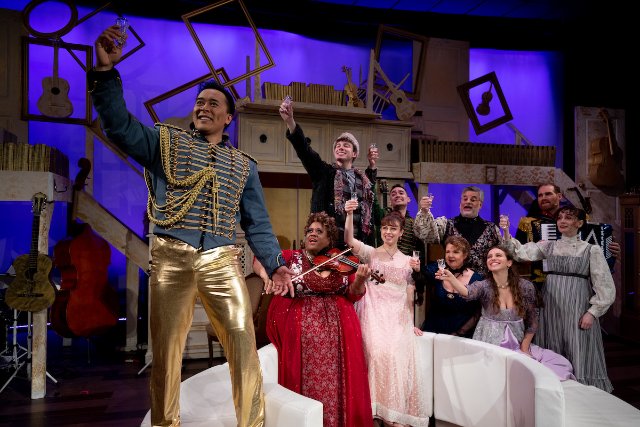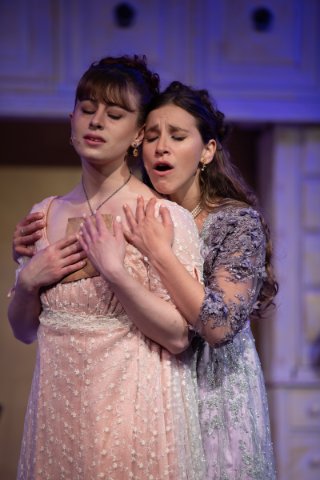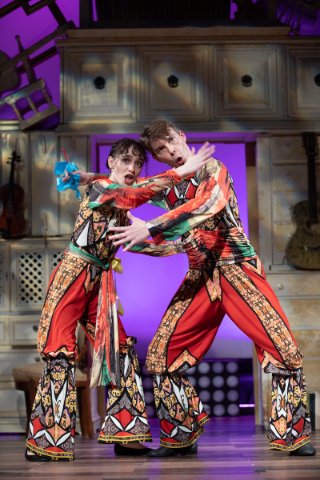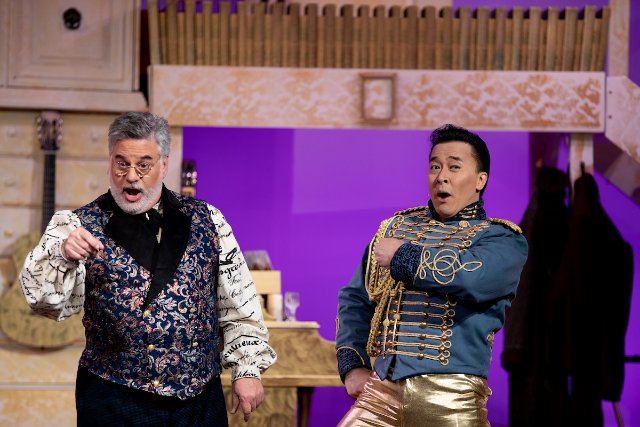Natasha, Pierre, and the Great Comet of 1812
Abbreviated "War and Peace" at a Breakneck Pace with Song
By: Victor Cordell - Apr 25, 2023
In a generic sense, the apotheosis of the 19th century’s Romantic Age occurred in Russia. Passionate, dreamy love prevailed in the higher social classes, not just in courtship, but in highly popular illicit relationships. Heroic individualism, evidenced by bold actions such as dueling and suicide, were admired. Poetry was sublime and emotional, dominated by Pushkin, whose death exemplified romanticism as he happened to be killed in a duel by his wife’s lover. Lush melodiousness infused serious music, led by composers Tchaikovsky, Mussorgsky, and Rimsky-Korsakov.
Into this socio-intellectual environment, one of the greatest minds of that or any age emerged - Leo Tolstoy. His epic novel “War and Peace” is noted as one of the most profound, respected pieces in world literature. Contemporary author and composer Dave Malloy took Part 8 of the great tome, which offers considerable insight into Russian culture of the time, as the basis for an award-winning musical “Natasha, Pierre, and the Great Comet of 1812.” It is now given a handsome, ingenious, and entertaining production by San Jose Playhouse.
The simple storyline centers on Natasha, betrothed to Prince Andrey, who has been sent to fight against Napoleon’s invasion of Russia. But when she visits Moscow, Natasha is taken with womanizer Anatole, and decides to abandon Andrey for the more glamorous option. Things don’t go as planned. The end.
Of course, events occur along the way. We meet a number of friends, relatives, and social acquaintances. In fact, the composer uses a clever device at the outset with a jaunty song in which characters introduce and give brief summaries of themselves. Later, there is a duel, an attempted suicide, intrigue, betrayal, and everything you would expect from a 19th century Russian novel.
The cast is talented and spirited, imbuing their characters with distinct personalities. The principal role is that of Natasha, portrayed by Paloma Maia Aisenberg, who invests it with smiling, youthful charm, though she will suffer angst from her choices as the narrative progresses. She sings with great confidence and skill for the greater part, but does sag a bit at times. Stephen Guggenheim exhibits a strong singing voice and a reserved countenance as the solid but stolid Pierre. The other key role is that of Anatole, which Jared Lee plays with the appropriate strut of a peacock and smirk of a seducer. He displays great vocal range but sounded thin in parts at this performance. In the ensemble, Corey Bryant deserves recognition for his bright showing in several roles from Balaga the troika driver to harlequin dancer in an appealing pas de deux.
In the operatic manner, this play is sung-through, though there is a fair bit of talk-sing and lyrics that are asymmetric to the music. The music is appealing throughout and highly gemischt, in keeping with the quick changes of mood and players as the scenes whiz by. To give a period feel, there is plenty of mournful Slavic/gypsy/klezmer influence, led by wailing woodwinds and accordions. But contemporary genres dominate, with the composer drawing on indie rock, Broadway, and even bluesy forms. The score mostly invigorates and brightens the tone, including some spontaneous clap-along, but the house was conspicuously hushed for the sensitive and lovely duet by the title characters at the climax.
The impressive production, adeptly directed by Scott Evan Guggenheim, is full of moving parts requiring extensive effort and coordination. A large number of vignettes are performed by an ensemble cast, with over two dozen musical numbers (Musical Director Stephen Guggenheim), many of which are choreographed with energetic dance by Shannon Guggenheim. The action takes place on Jon Gourdine’s attractive and versatile stage design, with dramatic lighting by Gourdine as well. The stage itself includes staircases and a catwalk, but action is further extended by a runway that goes into the seats and tees to the side aisles, facilitating considerable movement, dance, and intimacy with the audience. Finally, Julie Englebrecht’s costumes complete the look – women in Empire-waist dresses and men in military-styled tunics and cutaways, many with gold buttons and piping.
So, you might wonder about the title. If Natasha’s love interest shifts from Andrey to Anatole, where does Pierre fit in? Good question. Pierre is an older man who married Anatole’s disreputable sister, Hélène. Her interest in Pierre was for money and stability, and Pierre’s relationship with Natasha is as a consoler, so it is unclear why his name is linked in the title. Similarly, reference to The Great Comet occurs only at the very end of the play and can symbolize both destruction and renewal. It seems to appear in the title simply because it is catchy, and to give more gravitas to the play. Incidentally, the very real, spectacular comet was visible from earth for 260 days, but all within the year 1811. Possibly 1812 sounds more impressive and provides stronger historical connections because of Tchaikovsky’s popular “1812 Overture” and the War of 1812 between the U.S. and England.
“Natasha, Pierre, and the Great Comet of 1812,” with book, music, and lyrics by Dave Malloy, is based on Part 8 of the novel “War and Peace” by Leo Tolstoy, is produced by Guggenheim Entertainment and plays for San Jose Playhouse at 3Below Theaters, 288 South Second Street, San Jose, CA through May 28, 2023.





